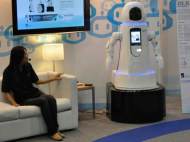Social robot OLIVIA developed to be used as a receptionist
 Researchers at A*STAR’s Social Robotics Programme (ASORO), integration of research capabilities of the Institute for Infocomm Research (I2R), the Data Storage Institute (DSI) and the Singapore Institute of Manufacturing Technology (SIMTech), are developing social robot OLIVIA – an experimental platform for social robot study. The folks from ASORO envision OLIVIA as a receptionist or a greeter.
Researchers at A*STAR’s Social Robotics Programme (ASORO), integration of research capabilities of the Institute for Infocomm Research (I2R), the Data Storage Institute (DSI) and the Singapore Institute of Manufacturing Technology (SIMTech), are developing social robot OLIVIA – an experimental platform for social robot study. The folks from ASORO envision OLIVIA as a receptionist or a greeter.
OLIVIA 2.1 is an experimental robotic platform used to evaluate various technologies relevant to social robotics. Robot’s height is 1.65 meter (5 feet 5 inches) and it weights 164kg (361.5 pounds). OLIVIA’s head can rotate or tilt up or down, and it is equipped with a pair of stereoscopic camera eyes. The stereoscopic camera eyes allow it to see 70 degrees wide, while additional 3rd mono-camera zooms in on the speaker’s face, letting OLIVIA determine whether someone is talking to it.
In order to find its way around surroundings, OLIVIA’s base features a Hokuyo URG04LX Laser Range Finder and sonar sensors for closer object or obstacles. The robot currently has arms with 6 degrees of freedom (DoF) in each arm. Each arm has 3 fingers, while each finger has 2 DoF (thus offering a total of 12 DoF in its both hands). When robot is out of use, it is able to retract its hands into the main body, thus saving space during transport and enhancing safety.
The robotic brain module, powered by an onboard Core i7 processor, makes it easier for various modules or algorithms to be integrated. It uses software to detect lip movements and determine if a person is speaking to it. OLIVIA is able to locate the source of human speech and turn its face in the direction of the speaker because it is equipped with eight microphones used to locate a source of sound in 3D. The robot is also equipped with additional 4 microphones in its chest and those are used for speech enhancement. Speech recognition is able to understand a vocabulary of 50,000 common English words, while an audio speaker inside the robot is used to reproduce robot’s voice which can be programmed to sound differently.
Various researches is currently undergoing using OLIVIA 2.1, which includes attention directed dialogue for sophisticated human-robot interaction and human-robot physical interaction to achieve safe and “soft” robotic motion. As you can see in the following video, they used motion detection in order to mimic movement. OLIVIA uses light rings to indicate whether it is idle or engaged with a human. Its developers claim that those light rings could be used to indicate robot’s mood.
As we mentioned in the beginning of our article, OLIVIA is an experimental platform and ASORO researchers want to develop it into a robot able to respond to natural speech. The current version is able to respond to specific phrases, greet a visitor and answer general inquiries, take the visitor’s information from visitor’s namecard, connect a host staff and a visitor via telephone, provide direction for visitors to navigate in office building or control electronic appliances such as lights by following voice commands. The folks from ASORO are developing another 2 robots meant for telepresence and for aid at home but we’ll describe those robots in our future articles.









Leave your response!